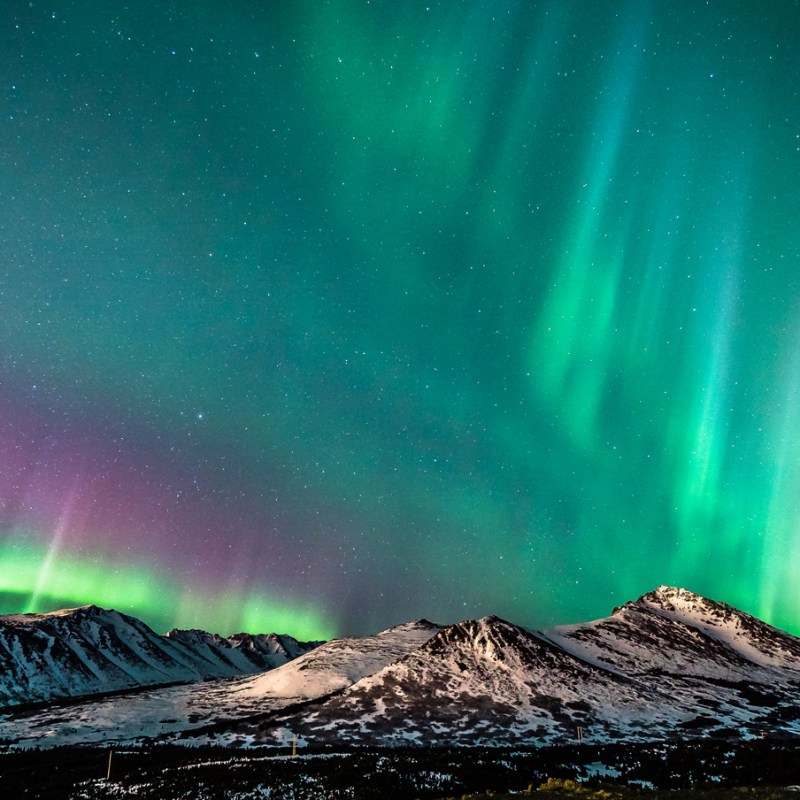
Seeing the aurora borealis (also known as the northern lights) is on many a bucket list. The easiest way to enjoy this incredible experience is from Anchorage, Alaska. The Ted Stevens Anchorage International Airport rarely closes for snow in the winter and with more than 240 flights arriving daily from two dozen national and international cities, you can almost always find a convenient flight.
Videos by TravelAwaits
The aurora season is fairly long in this area, and you might be surprised to know you can see the northern lights as early as August. Auroras near Anchorage tend to be brighter and more active. The natural features of mountains, boreal and temperate rainforest, the coastal areas, rivers, and lakes provide scenic backdrops to enhance your photos. There are a variety of ways to see the aurora borealis: you can take a tour, enjoy a stay at a luxury resort away from the city lights, or venture out on your own.
1. Anchorage Northern Lights Tour
Greatland Adventures, a local company, offers the Anchorage Northern Lights Tour. Their experts use the latest technology to decide the best dates and locations to see the aurora. Their tour locations are chosen based on the weather forecast, aurora strength, and the driving distance from Anchorage. Tours will pick you up from your Anchorage hotel between 8 and 11 p.m. in one of their comfortable, heated tour vehicles. Your professional Alaska guide will provide information on the aurora as well as basic photography instruction. You will also receive photographs and portraits from your visit. At the site are warm, winter shelters, snacks, and hot drinks. You will return between 3 and 6 a.m.

2. Anchorage Aurora Quest
Alaska Photo Treks offers Anchorage’s longest-running northern lights photo tour. This tour is designed for photographers, but sightseers are welcome. You will experience the mystery and magic of the aurora borealis with an experienced guide who will take you to their favorite super-secret spots within a 70-mile radius of Anchorage. The conditions-based tour lasts 6 hours and will travel to one to three locations. Your guide will share the nature and lore surrounding this magical experience. Your guide is also a professional photographer who will provide creative and technical photography instruction as well as professional portraits of you with the night sky and the aurora borealis. The company loans parkas and tripods. If you need a camera, you can rent a Sony mirrorless camera for the tour.

3. Alyeska Resort
The luxurious Alyeska Resort is located 40 miles from Anchorage and is nestled amidst the Chugach Mountains in the town of Girdwood. There is much less light pollution to interfere with your views of the northern lights. When staying at the resort, you can request a northern lights wake-up call. The best time to see the aurora is around midnight on a clear, cold, moonless winter night. You can see the lights from anywhere in the Girdwood area. The snow-covered peaks provide a lovely backdrop to the flashing colors of the aurora. Head out to Moose Meadows, a winter-time trail system. The flat, 2-mile trail is a great way to see the northern lights. Cross-country ski, walk, or rent snowshoes from the resort.
4. Aurora Forecast
If you are going to venture out on your own, you need to know when you can see the northern lights. The University of Alaska Fairbanks Geophysical Institute provides an Aurora Forecast. Scientists can predict when and where the aurora borealis will appear, but it is not as accurate as a weather report. Get familiar with Kp numbers. This is a scale that measures the strength of the aurora. Zero is calm, and nine means a major geomagnetic storm with strong auroras is visible. You will want forecasts of Kp 5 and above.

5. Anchorage Parks
There are many local parks just a short walk or drive from downtown Anchorage hotels. Head out to a secluded scenic overlook, where bright city lights are replaced by deep night skies and shimmering auroras (when the conditions are right). You will experience light pollution, but you will still be able to see the northern lights if they are bright enough. Point Woronzof Park is perched on a bluff 120 feet above the Knik Arm and is one of the most spectacular viewpoints in the city. During the day, it is known for its view of Denali and at night, you can sometimes see the northern lights. It is wide open to the northern sky and about 4 miles away from the glow of Anchorage. Earthquake Park has a parking area known as the Downtown Viewpoint. There is a clear view of the night skies and less light from downtown. The Captain Cook Monument and Resolution Park downtown offer expansive views of Mount Susitna, Denali, and Cook Inlet. You can view the aurora borealis from this spot in the distance. Many areas in Anchorage have no streetlights, and the northern lights are occasionally overhead (in which case you can see them anywhere in the city). How cool is that!
6. Flattop Mountain And Chugach State Park
The Glen Alps Overlook provides excellent views. It is at 2,200 feet in elevation and is arguably the best location to see the northern lights in Anchorage. Visitors are high enough up that Anchorage is a distant urban glow and there are unobstructed views of the northern sky. The more adventurous can hike up the mountain for even better views. Toilsome Road, which leads up to Glen Alps, has very steep grades and sharp switchbacks. If it is snowy or icy, you will need good winter tires or all-wheel-drive to make it up to this area.

7. Turnagain Arm
Heading southeast out of Anchorage along the Seward Highway, you will find a variety of places to see the aurora borealis. The turns of the road will soon leave Anchorage’s city lights and the dark skies will deliver glowing, dancing northern lights. Potter Marsh Bird Sanctuary and its boardwalks out into the marsh provide stunning views of the wetlands and surrounding mountains for a very unique viewing experience.
The Beluga Point wayside is a photographer’s dream as the mountains, sea, and sky all converge with the aurora borealis display. The sweeping 180-degree views of Turnagain Arm surrounded by mountains is the perfect photographic backdrop. If visiting in August, you may even get lucky enough to spot a beluga whale.
For a longer trip with multiple stops, drive to the head of Turnagain Arm and Portage Valley. This trip is best on a winter night with clear weather. From the parking lot on the shore of Portage Lake, the aurora bands can reflect off the ice of the frozen lake. This area is stunning in the winter with snow-covered mountains, river valleys, and frozen wetlands. There are also parking areas near both the Twentymile and Placer Rivers.
Pro Tips
- Make sure to have the proper winter gear for your trip. Many tour companies have parkas and other gear available to borrow or rent.
- Snowy and icy conditions can be dangerous for those with mobility issues. Check with your tour operator to see which locations are more accessible.
- Some of the sites you can visit on your own are easy to access from well-plowed roads, but others can involve driving up icy roads with steep switchbacks. Ensure your driving skills can handle these challenges.
- For this bucket list experience, you are going to want good photos. Bring a camera with manual settings and a wide-angle lens, a tripod, and a memory card with 16 GB or more of storage space. You can also take photos with your smartphone.
- Upload an aurora app; there are some specifically for photography. You will also need a tripod for your phone.
Anchorage, Alaska makes a great destination to experience the northern lights anywhere from downtown to further afield. There are options for every fitness and mobility level.

